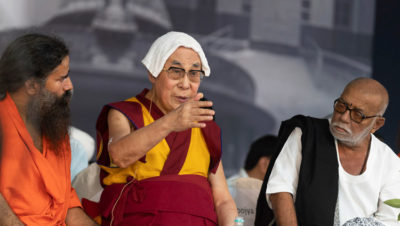
Baba Ramdev. and Morari Bapuji look on as His Holiness the Dalai Lama addresses the gathering during the interfaith program at Gandhi Ashram in New Delhi, India on September 25, 2019. Photo by Tenzin Choejor
September 25, 2019, New Delhi, India – This morning, His Holiness the Dalai Lama joined a number of spiritual leaders from Hindu, Muslim, Sikh, Jain and Christian traditions at the Gandhi Ashram in Delhi. They first paid their respects before Gandhi-ji’s memorial, and then planted a tree together in the courtyard outside the library to mark the occasion. His Holiness and the other spiritual leaders then assembled on the stage where Morari Bapuji yesterday began a ritual performance of the Ram Kathaa, recounting the life and deeds of Lord Ram, which will go on for nine days. Together with members of the Harijan Sevak Sangh they lit a lamp to mark the auspicious opening their interfaith gathering.
Dr. Shankar Kumar Sanyal welcomed the spiritual leaders to the ashram where Gandhi stayed and worked for the benefit of India and the whole world between 1930 and 1940. Each of the spiritual leaders spoke about the importance of cultivating religious harmony, upholding India’s ancient traditions of ‘ahimsa’ and ‘karuna’—non-violence and compassion—in addition to taking care of our planet. Representing the Hindu tradition were Sadhvi Bhagavathi Saraswati, Swami Chidanand Saraswati and Baba Ramdev. From the Shia tradition came Maulana Kokab Muharram. Giani Gurbachan Singh represented the Sikh tradition.
Father Ajit Patrick spoke on behalf of Christianity, while Maulana Mahmood Madani represented the Sunni tradition of Islam.
His Holiness greeted the spiritual leaders as brothers and sisters.
“Not only do all the major world religious traditions convey a message of love and peace, but they also teach how to increase these qualities,” he continued. “One of human beings’ best qualities is their ability to see other people as brothers and sisters. And it is on such a basis that we can live in harmony with each other.
“Nowadays, we see conflict and violence break out in the name of religion, despite its imparting a fundamental message of tolerance and faith in God. Nevertheless, this country provides a living example that religious traditions can live in harmony, which in turn is founded on the age-old practice of non-violent conduct prompted by a sense of compassion. Because of this sound sense of religious harmony, all the world’s major religions have flourished here in peace and free from fear for hundreds of years. The different philosophical views they propound are all focussed on extending compassion, which is their common message. Therefore, conflict in the name of religion is unthinkable.”
His Holiness advised that it is no longer enough for India simply to uphold religious harmony, she should take steps to encourage others to follow this example. He also observed that while one billion human beings alive today declare they have no interest in spiritual practice, they remain our brothers and sisters. Like us they wish to find happiness and overcome suffering. He emphasized that although methods for training the mind arose from spiritual practices for accomplishing tranquillity and insight—‘shamatha’ and ‘vipashyana’—, today, they can be studied and implemented in an objective academic way. The purpose would be to benefit all human beings whether they were believers or not.
“Even within Buddhism, we find the Pali and Sanskrit traditions. The Sanskrit tradition, upheld by masters like Nagarjuna, employs logic and analysis in relation to the Buddha’s teachings. Where they found that what the Buddha taught on some occasions contradicts reason, they declared that it be subject to interpretation. Such a sceptical approach can be adopted whether you are a believer or not.
“Something else we have to consider is that at the present time, when population growth and the climate crisis present a challenge to the whole of humanity, we need to take steps to protect the environment. This planet is our only home and if it becomes too hot for us to survive, there is nowhere else we can escape to. Therefore, we must try to protect our sources of water and restore forests by planting trees.”
In his concluding remarks His Holiness pointed out that if India’s ancient knowledge of the workings of the mind and emotions could be combined with modern education, many people could learn how to tackle their afflictive emotions and achieve peace of mind. Understanding that things do not exist the way they appear, which resonates with the view of quantum physics, is extremely helpful in countering negative mental states, such as anger, that are founded entirely on appearances.
After the musicians, who are performing the Ram Kathaa, had played several songs, Morari Bapu offered His Holiness a sapling. The event ended on a hospitable note with the various spiritual leaders eating lunch together before they dispersed.
https://www.dalailama.com/news/2019/visit-to-harijan-sevak-sangh-at-gandhi-ashram